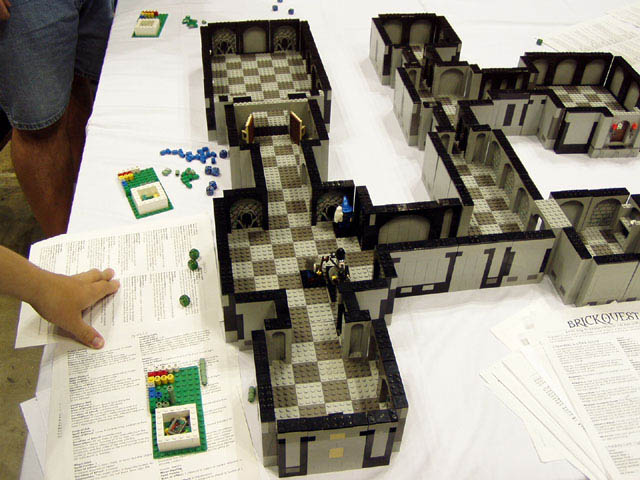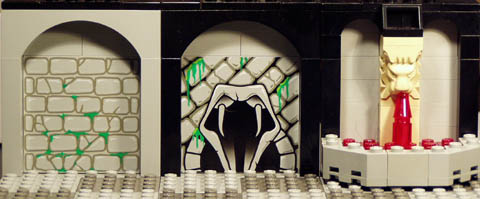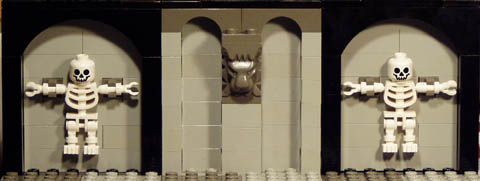
Dungeon Module System
Although you can build a one-use dungeon or complete rooms, a modular dungeon is most useful for BrickQuest. This page details how I build my own dungeons.
Please note:
This page is outdated. I'm using a new modular system but I'm still tweaking
it a bit. Check out the New Module System
but note that I haven't standardized on it yet.
Example
GenCon 2003 Dungeon #2

Components
Click any image to a page of instructions for building that component.
Floors
By using 4x4 squares,
these floors provide clear spaces where figures can move. Individual sections
of floor are connected with Technic pins. The 12 x 24 and 8 x 8 modules can
be reversed and put next to one another without breaking the pattern; other
floor sizes need to be done in two opposite patterns.
Walls
These are the basic walls which plug into floor segments. A lot of different
decorations are possible with these basic walls.
A few possibilities for an 8-stud long wall:


Connectors
These pieces are used as walls on connecting corridors. The wall height
is kept down to two bricks above the floor so players have easier access to
their figures and figures fit better in general. The connecting pins are set
off from normal walls to leave space for the walls on the rooms being connected.
Vending Machine
Heros get thirsty (not to mention wounded, poisoned, cursed, and short on spell
points!) as they go through a dungeon. What could be better to refresh a weary
hero than a nice cold potion? Put a vending machine in your dungeon today to
let those characters spend their hard-earned gold...
Secret Doors
There are a number of ways to handle secret doors. It's best not to put
out the room with the secret door already in place because players will know
immediately where to search. Here are two ways to handle it:
|
1. Start the room out with another modular wall where the secret door will be.
|
2. When it's found and opened, just remove that module and plug in the floor of the room revealed.
|
Method 2:
|
1. Start the room out with another modular wall where the secret door will be.
|
2. When it's found, replace it with a specially-built secret door module (instructions coming soon?)
|
|
3. When a player opens it, swing the door back.
|
4. Then connect the room on the far side.
|
If you're making a non-modular dungeon but you want to include secret doors, you might want to build in several secret doors, some of which are actually false. In any case, the roll to locate secret doors or traps should be made by the BrickMaster and kept hidden from the players--they shouldn't know if there's not a door someplace or that they just didn't find it.
BrickQuest: By Peter F. Guenther, 2003-2007
 The BrickQuest rules and the contents of this site are licensed under a
Creative Commons Attribution-Noncommercial-Share Alike 3.0 United States License.
The BrickQuest rules and the contents of this site are licensed under a
Creative Commons Attribution-Noncommercial-Share Alike 3.0 United States License.
Questions or Comments? Email peterg1974@hotmail.com
LEGO® is a trademark of the LEGO
Company, which does not sponsor, authorize or endorse this site.